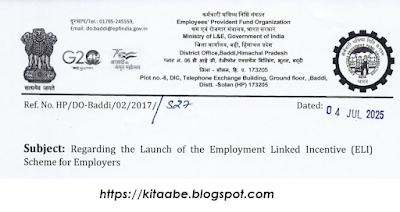Free E-Books & Govt.Docs
Download 100% Free E-Books and Govt. Documents, Circulars, Acts etc..
नि:शुल्क श्रीरामचरित मानस PDF डाउनलोड करें [Free Download Shri Ramcharit Manas]
विनय पत्रिका : भक्तिरस से सराबोर एक अनमोल ग्रंथ
हिन्दी साहित्य और भक्तिकाव्य की परंपरा में गोस्वामी तुलसीदास का नाम अमर है। रामचरितमानस की भांति उनकी एक और कृति है – “विनय पत्रिका”, जो भक्त और भगवान के बीच आत्मीय संवाद का अद्भुत संकलन है।
विनय पत्रिका का परिचय:
यह ग्रंथ गोस्वामी तुलसीदास जी की रचना है, जिसमें 279 पद (कविताएं) संकलित हैं।
इसमें भक्त का अपने आराध्य श्रीराम के प्रति गहन प्रेम, श्रद्धा, और समर्पण झलकता है।
इसे “प्रार्थना-पत्र” भी कहा जाता है, जिसमें भक्त अपने हृदय की व्यथा और विनय भगवान के चरणों में अर्पित करता है।
विनय पत्रिका का महत्व:
इसमें भक्तिरस का अद्वितीय प्रवाह मिलता है।
भगवान श्रीराम के प्रति दीनता, समर्पण और प्रेम की भावनाएं सरल भाषा में व्यक्त की गई हैं।
यह ग्रंथ साधक के मन को कोमलता और शांति प्रदान करता है।
नियमित पाठ से भक्त के हृदय में भक्ति, विनय और कृपा की भावना प्रबल होती है।
क्यों पढ़ें विनय पत्रिका?
यह हमें नम्रता, करुणा और भगवान पर निर्भरता का संदेश देती है।
इसमें केवल काव्य रस ही नहीं, बल्कि जीवन जीने की गहरी शिक्षा भी निहित है।
भक्त और भगवान का यह संवाद आत्मा को शुद्ध करने वाला है।
निष्कर्ष:
“विनय पत्रिका” केवल एक काव्यग्रंथ नहीं, बल्कि भगवान के प्रति भक्त के प्रेम और विनम्रता की जीवंत गाथा है। जो भी व्यक्ति भक्ति मार्ग को अपनाना चाहता है, उसके लिए यह ग्रंथ पथप्रदर्शक है।
👉 विनय पत्रिका PDF डाउनलोड करने के लिए यहाँ क्लिक करें: [DOWNLOAD PDF HERE]
सौन्दर्य लहरी : एक अद्भुत धार्मिक ग्रंथ [नि:शुल्क डाउनलोड करें]
भारतीय संस्कृति और आध्यात्मिक धारा में अनेक ग्रंथ ऐसे हैं, जिनमें देवी उपासना का गूढ़ रहस्य छिपा है। इन्हीं में से एक है “सौन्दर्य लहरी”, जिसे आदि शंकराचार्य द्वारा रचित माना जाता है। यह ग्रंथ केवल स्तोत्र नहीं, बल्कि एक ऐसा आध्यात्मिक विज्ञान है जिसमें देवी की महिमा, साधना विधि और तांत्रिक रहस्य समाहित हैं।
सौन्दर्य लहरी का महत्व
यह ग्रंथ 100 श्लोकों का संग्रह है, जो देवी की आराधना, सौंदर्य और शक्ति की महिमा का वर्णन करते हैं।
इसमें प्रथम 41 श्लोक को “आनन्द लहरी” कहा जाता है, जिसमें शक्तिपूजन के गूढ़ रहस्य बताए गए हैं।
शेष 59 श्लोक “सौन्दर्य लहरी” कहलाते हैं, जिसमें माँ भगवती के दिव्य स्वरूप और सौंदर्य का अलौकिक वर्णन मिलता है।
सौन्दर्य लहरी केवल भक्ति का ग्रंथ नहीं, बल्कि साधना मार्गदर्शिका भी है, जिसमें यंत्र, मन्त्र और तांत्रिक साधना के सिद्धांत वर्णित हैं।
क्यों पढ़ें सौन्दर्य लहरी?
यह ग्रंथ आध्यात्मिक साधक को आत्मिक शक्ति प्रदान करता है।
इसमें देवी की कृपा प्राप्त करने के सरल और सुगम उपाय बताए गए हैं।
यह शांति, सुख और समृद्धि की प्राप्ति का मार्ग दिखाता है।
सौन्दर्य लहरी का नियमित पाठ साधक को आत्मबल और आत्मसाक्षात्कार की ओर ले जाता है।
निष्कर्ष:
सौन्दर्य लहरी केवल एक धार्मिक ग्रंथ नहीं, बल्कि शक्ति, भक्ति और साधना का अद्भुत संगम है। यदि आप देवी उपासना और आध्यात्मिक साधना की गहराई को समझना चाहते हैं, तो यह ग्रंथ आपके लिए अनमोल खजाना साबित होगा।
👉 सौन्दर्य लहरी PDF डाउनलोड करने के लिए यहाँ क्लिक करें: [DOWNLOAD PDF]
Himachal Pradesh Minimum Wages April 2025
Whereas, the Governor, Himachal Pradesh is of the opinion that the minimum rates of wages in respect of unskilled category of workers in the Scheduled employment of ''Agriculture'' may be revised with effect from 01-04-2025
Store and Protect your Data in the Cloud - Free e-book
Download
Popular Documents
-
Just before dawn one winter's morning, a hijacked jetliner explodes above the English Channel. Through the falling debris, two figures, ...
-
इस्लाम में धर्मांतरण के मुख्य साधन थे म्रत्यु भय या परिवार को गुलाम बनाये जाने का भय, आर्थिक लोभ ( पारितोषिक, पेन्शन, लूट का माल ) धर्म...
-
The Himachal Pradesh Tenancy and Land Reforms Act, 1972 Full Scanned Copy. Download
-
रंगीला रसूल १९२० के दशक में प्रकाशित पुस्तक है जो लाहौर के राजपाल एण्ड सन्स ने प्रकाशित की थी। इसके लेखक 'चामुपति एम ए' या किश...
-
ज्योतिष्य स्वयं शिक्षक - फल ज्योतिष - पी. एन. ओक (हिंदी में ) Download
-
Download Full Free The Code of Criminal Procedure, 1973 Bare Act. Download
-
The pre-eminent political and spiritual leader of India's independence movement, pioneer of non-violent resistance to tyranny thro...
-
Minimum Wages Notification of Himachal Pradesh 19th May 2012. Download PDF File.












